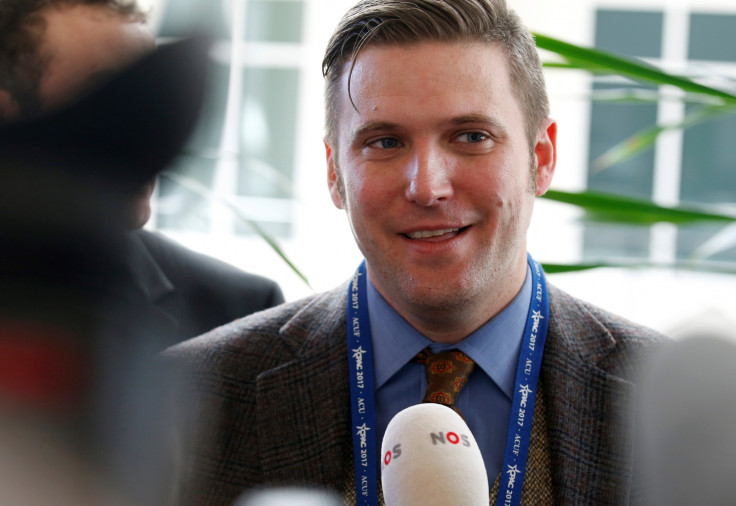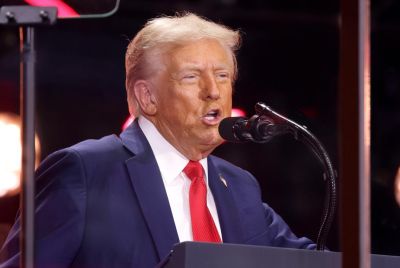Alt-right idealogue Richard Spencer expelled from Republican CPAC conference
Mainstream conservatives expel figurehead from anti-immigrant, anti-Semitic fringe movement.

White nationalist and alt-right figurehead Richard Spencer says he was kicked out of the prominent US Conservative CPAC conference on Thursday (23 February) after it hosted a panel attacking him. The move comes among other signs that the fringe movement is being sidelined by more mainstream conservative groups.
"I was expelled from CPAC. They denounced us on stage. They had a totally stupid talk about us. I would have expected at least Wikipedia level research about us to be done," said Spencer in an online video after he was asked to leave the building.
Spencer was referring to a talk hosted by Dan Schneider, Executive Director of the American Conservative Union, which puts on the conference every year. The talk was titled "the alt-right ain't right at all."
"He is not welcome here. He was removed from the premises," wrote CPAC spokesman Ian Walters in an email. Spencer, Walters said, bought a general admission ticket to the event and was not invited.
"He was not credentialed as media, and did not gain entrance via any of our partner organizations," said Walters. "Our attendees are here to learn about conservatism and talk about working toward solutions for the important issues we will face as a nation over the next year."
Spencer has styled himself a leading light in the alt-right movement, which has gained attention for its ardent support for US President Donald Trump. There is no defined core ideology for the alt-right, but it is a lose collection of people who speak in generally anti-immigrant, racist, xenophobic, and anti-Semitic tones. Many also take a deep interest in conspiracy theories.
Spencer aims to create a whites-only ethno-state. He was condemned by Washington DC's US Holocaust Museum in November 2016, soon after Trump's election win, for holding an event where his shouts of "hail Trump!" drew Nazi salutes from the crowd.
Trump's chief strategist Steve Bannon, who is speaking at CPAC has been associated with the alt-right movement as well. Up until he was hired as Trump's campaign manager in August, he was executive chair of Breitbart News, which he described as "the platform for the alt-right" during the Republican National Convention in July 2016.
Although many of Breitbart's reporters and editors are moderating talks at CPAC, one of the alt-right's champions, former Breitbart editor Milo Yiannoplolous, drew controversy this week after he was dropped from speaking there for making comments on relations between older men and underage boys. He also lost his job and a book deal in the process.
Following the talk aimed against him, Spencer said that he spoke with the media in the CPAC conference hall for about an hour. One passerby called him "a piece of s**t." Spencer told reporters the man is a moron who can't dress.
"There was tons of interest," Spencer said, "people who had never heard of us who came up to me and wanted to talk."
A man just called Richard Spencer "a piece of sh*t." Spencer says he's a moron who can't dress. #CPAC2017 pic.twitter.com/XxQHyaLLue
— Amber Ferguson (@Ms_AmberDawn) 23 February 2017
What is the alt-right?
The alt-right is a loose collection of people with far-right views that came into prominence during Donald Trump's election campaign. Many members operating online profess views related to white supremacism, nationalism, anti-feminism and Islamophobia, amongst others. There isn't a defined core ideology to the movement, aside from a rejection of America's mainstream conservatism. Alt-right members generally supported Donald Trump and hailed campaign promises to build a wall along the US-Mexico border and ban Muslims from entering the country.
With the rise of Steve Bannon, who was appointed as chief strategist and counsellor to the president in Trump's White House team, there are fears that the alt-right now has a voice in the Oval Office. Bannon was previously executive chairman of the Breitbart News website, which he once called "a platform for the alt-right".
© Copyright IBTimes 2025. All rights reserved.





















